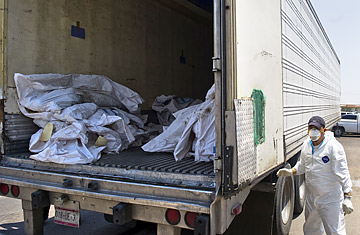
Forensic personnel stands next to a trailer containing bodies found in mass graves across the Mexican city of Durango, on May 16, 2011.
Mexican soldiers found a seventh mass grave in Durango, Mexico, this week, and its location was as unexpected as the six before it. TIME was one of the first media at the scene on Thursday, May 19, as forensic officials descended on a white stucco house in the upscale Jardines de Durango neighborhood to unearth presumed drug-cartel victims buried in the garden. Like the other grisly fosas, or narco-graves, uncovered in this northern desert city since last month — many of which were in middle-class backyards or near schools — the latest raised an unsettling question: How could residents and authorities not know something was terribly amiss at the house on Calle Petunias? "That's the incredible part," says Jorge Santiago, spokesman for Durango State Human Rights Commission.
Just as staggering is the number of bodies recovered so far in the Durango fosas: 218, a figure sure to rise with the newest discovery, and which surpasses the 183 exhumed since last month in the border state of Tamaulipas. Like the Tamaulipas corpses, many of those found in Durango are believed to be innocents as well as mafiosos. Either way, the sheer volume has human rights advocates looking at Mexico's bloody drug war, which in four years has produced almost 40,000 gangland murders, through a more disturbing prism. To them it smacks of massacres witnessed in the Balkans in the 1990s, or Central America in the 1980s or South America in the 1970s — especially since corrupt Mexican police, like the 17 arrested for alleged involvement in the Tamaulipas slaughter, frequently take part. "It's purely demoniacal," says Javier Sicilia, a Mexican poet whose son, Juan Francisco Sicilia, 24, was murdered by narco-criminals this year. "It threatens our democracy."
But like the killing of Sicilia's son, the macabre fosas are also putting more human names and faces on the victims of Mexico's narco-carnage, including the thousands of missing persons. As bodies, many badly decomposed, were brought to refrigerated trailers behind the Durango state attorney general compound this week, hundreds of families braved the overpowering stench to come and take DNA tests, hoping to find out if any of the fosa dead are loved ones who violently disappeared months or years ago — either because they were involved in drug trafficking themselves, or because they were targeted for robbery, kidnapping and extortion amid turf battles between gangs like the powerful Sinaloa Cartel and the vicious army commandos-turned-narcos known as the Zetas.
Among those coming forward was Rosario López, 34, a Durango hair stylist whose longtime boyfriend, Julio César Rocha, 23, a car stereo technician, was snatched off the street seven months ago by suspected narcos — who, say witnesses, may also have been cops — in a black Ford Lobo truck. López says local authorities have done little to investigate his disappearance. (More than 90% of Mexico's violent crimes go unsolved.) But after convincing his parents to offer DNA samples, she now waits to see if Rocha is one of those recently exhumed — to get closure but, just as important, to finally force a professional probe into his case. "It's a pain, a daily anguish you can't describe," says López, who lived with Rocha and planned to marry him. "These criminals don't just take people, they take away whole futures."
Residents like López applaud the state and federal governments for giving them access to the DNA tests. But other families, many arriving at the attorney general's office from nearby states, were more circumspect — worried that narco spies were scattered around the compound listening to their conversations. Durango officials fear it too. "We don't know who's friend or enemy here anymore," one told TIME.
One hope, says Sicilia, who has turned his son's killing into a surprisingly broad civic protest movement against Mexico's violence, is that cases like Rocha's will help the world realize "that the dead aren't just figures and abstractions, narcos killing narcos, but potentially all of us." And that in turn may put pressure on Mexican leaders to get more serious about judicial and police reform — which is the country's only real solution to the narco-crisis, and which President Felipe Calderón has pushed along with his gutsy but ill-conceived military campaign against the cartels — and on U.S. leaders to reduce the drug consumption and smuggled guns that play such a large role in the tragedy south of the border.
Calderón sent federal forensic aid to Durango this week to help state investigators, who human rights monitors had complained were ruining evidence at the fosas by using large backhoes to extract bodies. (Calderón, however, didn't help his p.r. cause on Thursday when, during a visit to Las Vegas to promote Mexican tourism, he less than tactfully quipped that the "only shots" visitors to Mexico will face are "tequila shots.") As more decapitated bodies begin turning up in the city — including that of a local high-ranking prison official — the President has also sent in highly trained Marine units.
To symbolize the shared responsibility of the drug war, Sicilia's Hasta la Madre! (We've Had It!) movement supporters are planning a caravan next month from Mexico City to the violence-plagued border city of Juárez. There they hope a southbound American caravan will arrive across the Rio Grande at the U.S. border city of El Paso, Texas. It won't end Mexico's narco-violence, but it might wake more people up to the kind of human horror that Durango is now discovering in its gardens.
